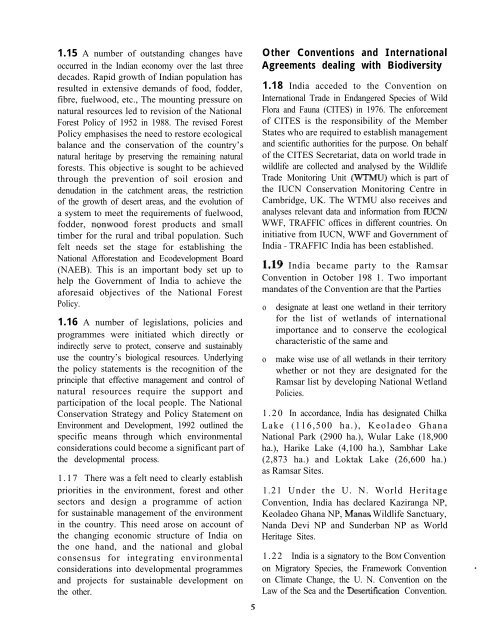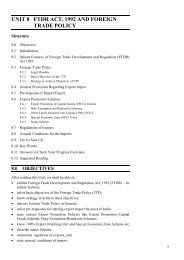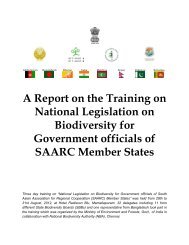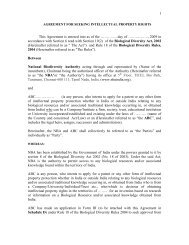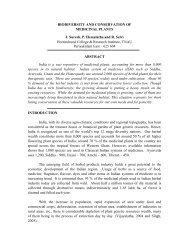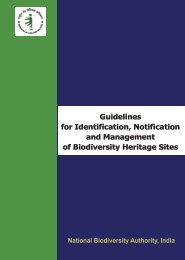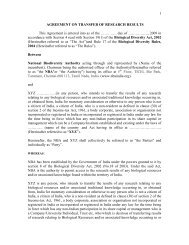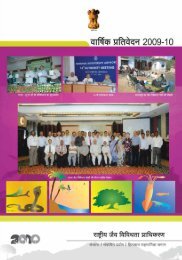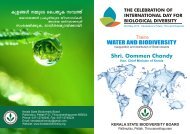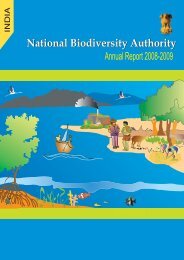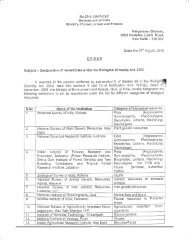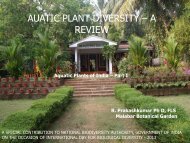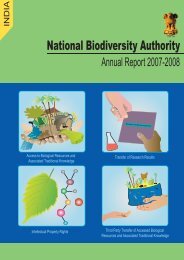CBD First National Report - India - National Biodiversity Authority
CBD First National Report - India - National Biodiversity Authority
CBD First National Report - India - National Biodiversity Authority
You also want an ePaper? Increase the reach of your titles
YUMPU automatically turns print PDFs into web optimized ePapers that Google loves.
1.15 A number of outstanding changes haveoccurred in the <strong>India</strong>n economy over the last threedecades. Rapid growth of <strong>India</strong>n population hasresulted in extensive demands of food, fodder,fibre, fuelwood, etc., The mounting pressure onnatural resources led to revision of the <strong>National</strong>Forest Policy of 1952 in 1988. The revised ForestPolicy emphasises the need to restore ecologicalbalance and the conservation of the country’snatural heritage by preserving the remaining naturalforests. This objective is sought to be achievedthrough the prevention of soil erosion anddenudation in the catchment areas, the restrictionof the growth of desert areas, and the evolution ofa system to meet the requirements of fuelwood,fodder,forest products and smalltimber for the rural and tribal population. Suchfelt needs set the stage for establishing the<strong>National</strong> Afforestation and Ecodevelopment Board(NAEB). This is an important body set up tohelp the Government of <strong>India</strong> to achieve theaforesaid objectives of the <strong>National</strong> ForestPolicy.1.16 A number of legislations, policies andprogrammes were initiated which directly orindirectly serve to protect, conserve and sustainablyuse the country’s biological resources. Underlyingthe policy statements is the recognition of theprinciple that effective management and control ofnatural resources require the support andparticipation of the local people. The <strong>National</strong>Conservation Strategy and Policy onEnvironment and Development, 1992 outlined thespecific means through which environmentalconsiderations could become a significant part ofthe developmental process.1.17 There was a felt need to clearly establishpriorities in the environment, forest and othersectors and design a programme of actionfor sustainable management of the environmentin the country. This need arose on account ofthe changing economic structure of <strong>India</strong> onthe one hand, and the national and globalconsensus for integrating environmentalconsiderations into developmental programmesand projects for sustainable development onthe other.Other Conventions and InternationalAgreements dealing with <strong>Biodiversity</strong>1.18 <strong>India</strong> acceded to the Convention onInternational Trade in Endangered Species of WildFlora and Fauna (CITES) in 1976. The enforcementof CITES is the responsibility of the MemberStates who are required to establish managementand scientific authorities for the purpose. On behalfof the CITES Secretariat, data on world trade inwildlife are collected and analysed by the WildlifeTrade Monitoring Unit which is part ofthe IUCN Conservation Monitoring Centre inCambridge, UK. The WTMU also receives andanalyses relevant data and information fromWWF, TRAFFIC offices in different countries. Oninitiative from IUCN, WWF and Government of<strong>India</strong> TRAFFIC <strong>India</strong> has been established.<strong>India</strong> became party to the RamsarConvention in October 198 1. Two importantmandates of the Convention are that the Partiesoodesignate at least one wetland in their territoryfor the list of wetlands of internationalimportance and to conserve the ecologicalcharacteristic of the same andmake wise use of all wetlands in their territorywhether or not they are designated for theRamsar list by developing <strong>National</strong> WetlandPolicies.1.20 In accordance, <strong>India</strong> has designated ChilkaLake (116,500 ha.), Keoladeo Ghana<strong>National</strong> Park (2900 ha.), Wular Lake (18,900ha.), Harike Lake (4,100 ha.), Sambhar Lake(2,873 ha.) and Loktak Lake (26,600 ha.)as Ramsar Sites.1.21 Under the U. N. World HeritageConvention, <strong>India</strong> has declared Kaziranga NP,Keoladeo Ghana NP, Wildlife Sanctuary,Nanda Devi NP and Sunderban NP as WorldHeritage Sites.1.22 <strong>India</strong> is a signatory to the BOM Conventionon Migratory Species, the Framework Conventionon Climate Change, the U. N. Convention on theLaw of the Sea and theConvention.


